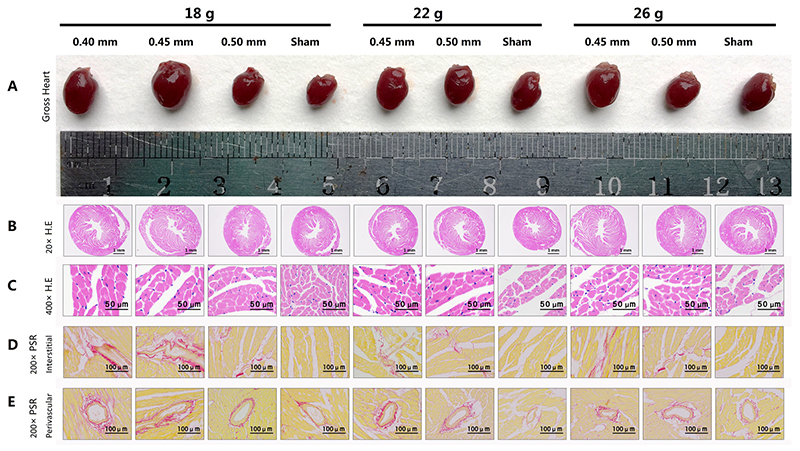Volume 110, Nº 6, June 2018
DOI: http://www.dx.doi.org/10.5935/abc.20180088
ORIGINAL ARTICLE
Pressure Overload-induced Cardiac Hypertrophy Varies According to Different Ligation Needle Sizes and Body Weights in Mice
Zhen Jia
Zhijun Chen
Hongfei Xu
Malik Akuffu Armah
Peng Teng
Weidong Li
Dongdong Jian
Liang Ma
Yiming Ni

Figure 1 – Cardiomyocyte hypertrophy and collagen deposition histological examination. (A) Gross hearts under natural light. (B) The 20 × microscopic views of HE sections. (C) The 400 × microscopic views of HE sections. (D) Representative 200×microscopic views under standard lights of PSR sections in the interstitial space. (E) Representative 200 × microscopic views under standard lights of PSR sections in the perivascular space. Fibrosis is presented as red in the PSR sections.
Abstract
Background: The cardiac hypertrophy (CH) model for mice has been widely used, thereby providing an effective research foundation for CH exploration.
Objective: To research the effects of CH modeling under abdominal aortic constriction (AAC) using different needles and weights in mice.
Methods: Four needles with different external diameters (0.35, 0.40, 0.45, and 0.50 mm) were used for AAC. 150 male C57BL/6 mice were selected according to body weight (BW) and divided into 3 weight levels: 18 g, 22 g, and 26 g (n = 50 in each group). All weight levels were divided into 5 groups: a sham group (n = 10) and 4 AAC groups using 4 ligation intensities (n = 10 per group). After surgery, survival rates were recorded, echocardiography was performed, hearts were dissected and used for histological detection, and data were statistically analyzed, P < 0.05 was considered statistically significant.
Results: All mice died in the following AAC groups: 18g/0.35 mm, 22 g/0.35 mm, 26 g/0.35 mm, 22 g/0.40 mm, and 26 g/0.40 mm. All mice with AAC, those ligated with a 0.50-mm needle, and those that underwent sham operation survived. Different death rates occurred in the following AAC groups: 18 g/0.40 mm, 18 g/0.45 mm, 18 g/0.50 mm, 22 g/45 mm, 22 g/0.50 mm, 26 g/0.45 mm, and 26 g/0.50 mm. The heart weight/body weight ratios (5.39 ± 0.85, 6.41 ± 0.68, 4.67 ± 0.37, 5.22 ± 0.42, 4.23 ± 0.28, 5.41 ± 0.14, and 4.02 ± 0.13) were significantly increased compared with those of the sham groups for mice with the same weight levels.
Conclusion: A 0.45-mm needle led to more obvious CH than did 0.40-mm and 0.50-mm needles and caused extraordinary CH in 18-g mice. (Arq Bras Cardiol. 2018; 110(6):568-576)
Keywords: Cardiomegaly; Body Weight; Heart Failure; Needles/utilization; Rats.















